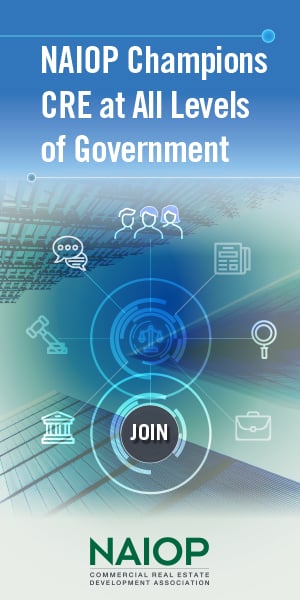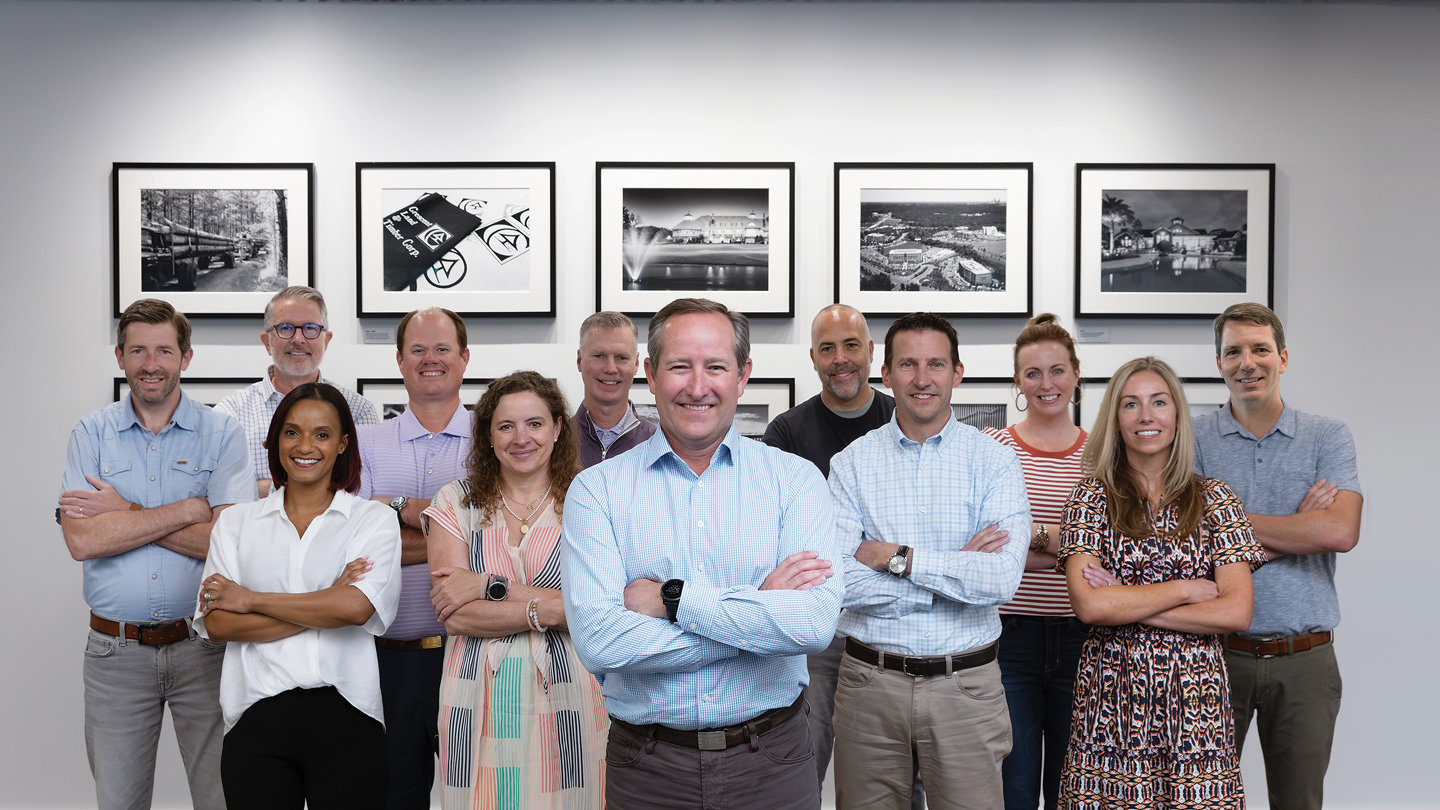
Crescent Communities: Building Communities That Better People’s Lives
NAIOP’s 2024 Developer of the Year has been a pioneer in the creation of high-quality communities in thriving Sun Belt markets for over 60 years.
Since 1963, Crescent Communities has developed 85 multifamily communities and 24 million square feet of commercial space. Established as Crescent Land and Timber within Duke Energy’s forestry department, the company was renamed Crescent Resources in 1989, focusing on residential master-planned communities, before assuming its current name in 2013.
Sumitomo Forestry Group, a Japanese company, acquired Crescent in 2018. Since then, it has grown into a nationally recognized, market-leading real estate investor, developer and operator of mixed-use and industrial communities. The company is active in 17 markets and has offices in Charlotte, Atlanta, Dallas, Nashville, Orlando, Phoenix and Washington, D.C.
For its outstanding performance, ability to adapt to challenging market conditions, excellent community relations, positive company culture, financial success, continuous innovation, NAIOP involvement, philanthropic endeavors, premier developments and environmental sustainability practices, Crescent Communities has been named NAIOP’s 2024 Developer of the Year.
“It is NAIOP’s honor to recognize the tremendous work of Crescent Communities as the 2024 Developer of the Year. Its ongoing commitment to advancing the commercial real estate industry through cutting-edge innovation and exemplary real estate development across many property sectors is impressive,” said NAIOP President and CEO Marc Selvitelli. “Crescent Communities has demonstrated significant market resilience and adaptability, overcoming economic headwinds to consistently deliver value.”
Since 1979, the NAIOP Developer of the Year award has been presented to a development company that best exemplifies leadership and innovation in the commercial real estate industry. Crescent Communities was selected from an outstanding slate of nominees and evaluated by a team of seasoned developers.
“We are honored to be named NAIOP’s Developer of the Year. It serves as a testament to the remarkable people at Crescent Communities and the exceptional collaboration and performance they have exhibited over the years,” said Brian Natwick, chairman and CEO of Crescent Communities.

Colleagues from around the country gather at Crescent Communities’ Greater Purpose meetings every two years to build relationships and camaraderie across the company. Crescent Communities
Natwick has been with Crescent for almost two decades, joining the firm’s multifamily team in 2006 and later serving as president and COO before assuming his current role in 2021. Before joining Crescent, he held senior management and executive positions at Centex Construction Co., Skanska USA Building, and Moss & Associates, and he was responsible for over $500 million of development for notable clients such as Walt Disney Imagineering, Hilton/LXR Luxury Resorts and Blackstone Group.
Strategic Thinking
Strategic thinking is the compass that guides Crescent Communities. Every half-decade, the company collaboratively develops a new five-year strategic plan. “The primary objective is to look at where we want to focus and, just as importantly, where we do not want to focus,” Natwick said.
He added that after creating a strategic plan, it is critical to stick to that plan rather than getting distracted by other opportunities that pop up, which would serve only to dilute the firm’s overall effort and focus. “We are highly invested in what we do,” he emphasized, “but every five years, we want to put it all on the table and look at the markets we are in.”
Importantly, many leaders at the company participate in the five-year planning process. “It’s not just a small group at the top that decides,” Natwick noted. “It is a research-based, highly collaborative undertaking with various people involved, and it has yielded huge results for us.”
It’s Community, Community, Community
Crescent is also strategic in how it visualizes and talks about its various endeavors. “We use the word ‘community’ intentionally. At the same time, we stay away from words like ‘property,’ ‘project’ and ‘development’ because those words are physical, nonliving things,” Natwick explained. “Community is a much more interactive, engaging and evolving concept. It is evergreen.”
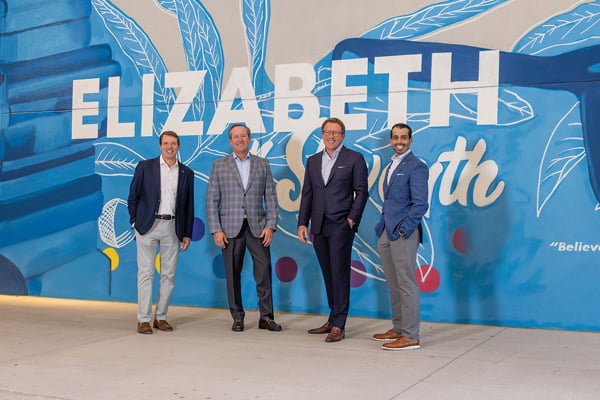
From left, Brendan Pierce, Brian Natwick and Managing Directors Chase Kerley and Sagar Rathie in front of a mural by Jeremy Biggers honoring civil rights advocate Harry Golden at the entrance to the parking garage at Elizabeth on Seventh in Charlotte, North Carolina. Crescent Communities believes public art is part of the fabric of communities and routinely recruits local artists to transform blank walls, parking decks and garages into colorful creations that become landmarks in their respective cities. Crescent Communities
Crescent looks at the long term in all its undertakings. “Sometimes I am asked why a particular community is so successful,” Natwick said. “I tell them, ‘With our communities, it is never one, two or even three things that we do — it is everything we put into the community.’ There is a tremendous amount of intentionality at the beginning to create a unique and authentic vision for each community. We use that vision to influence the programming, design, execution, construction and marketing. We develop a story that helps us attract capital to invest into the community and also helps us attract capital when it is time to sell.”
The CANVAS Process
Community relations can be an ongoing issue for developers. “I don’t blame neighborhood or community groups [for opposing development] because it is always an unknown,” Natwick said. “We work in 10 states and 17 markets focusing on the Sun Belt, which is our footprint. We are highly focused on the high-growth areas where organizations, people and families want to live. In many of these areas, we are developing in someone’s backyard … and no one wants anything in their backyard. We completely understand this, so we engage the community at the outset because we want their input. When you approach it as a friend rather than as a foe, it is much more productive.”
Many commercial real estate developers undertake good-faith efforts to listen to community stakeholders before launching a project, but Crescent Communities uses a process called CANVAS to ensure many voices are heard and responded to when a new community is being created.
According to the company, the CANVAS process occurs before a single shovel breaks ground. The focus goes far beyond a design charette — it is a process through which community members, neighbors, business owners and the Crescent team come together and ask one another: “How can we build a community that betters the community?”
During the process, visions evolve in step with foundational design principles to create intention. These principles are carried throughout the development’s life cycle like a North Star. Results from the CANVAS process have included:
- Expansion of greenways and parks near Crescent’s communities
- Construction of affordable housing units
- Donation of land for affordable housing
- Installation of public art in communities
Company Culture
Crescent Communities, which has 194 employees, has cultivated a strong company culture that helped steer it through the pandemic and keeps it on a prosperous path, Natwick said.
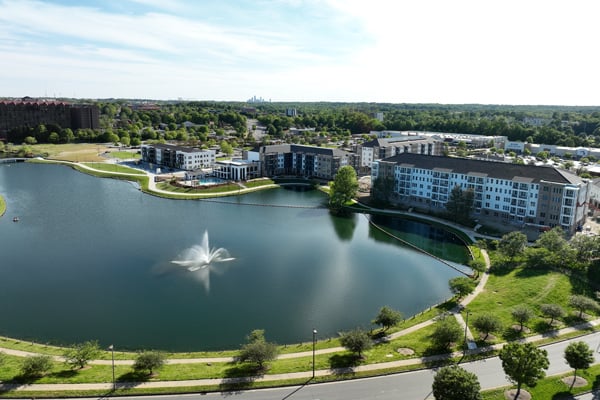
NOVEL University Place, in the northern part of Charlotte, is an example of Crescent Communities’ Class A multifamily offerings. The lakefront community includes a resident amenity building, a resort-style pool and hammock park, and nearby access to light rail and existing greenway trails. Crescent Communities
He added that the company’s employee retention rate is reflective of its positive culture. “Our people love what they do and love the people they are working with. We have created a team of highly entrepreneurial, collaborative and successful people. It’s a lot of fun to be part of a team that wins, but we believe that winning is a result, not the objective.”Another factor that adds to Crescent’s highly positive culture is its focus on diversity and inclusion. Crescent seeks to foster teams composed of people with different backgrounds, experiences, styles, genders and races. Natwick said Crescent values diverse perspectives and supports team member engagement.
The company is also intentional about developing partnerships that foster diversity and equity and seeking diverse vendor relationships in all areas of construction and business operations. While proud of what it has already accomplished in creating a more diverse and equitable workplace, Crescent also understands this is an ongoing journey with no finish line and is actively working to find opportunities for growth in this area.
“I believe it is important to have diverse thinking in everything we do,” Natwick stressed. “It can be natural to surround yourself with people who think like you, behave like you and perhaps even look like you. But cultivating diversity also encourages folks to think differently.”
Financial Success
Like other commercial real estate companies, Crescent Communities has been confronted with issues such as high interest rates, rising material costs and material disruptions. But the company follows a strategy that helps it achieve financial success in good markets and bad.
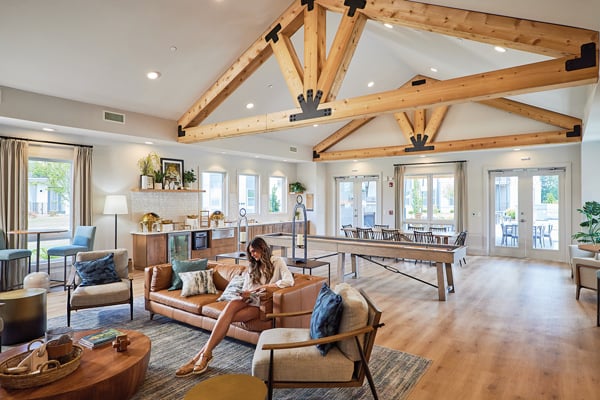
RENDER Covington is the first community under Crescent’s RENDER multifamily brand, aimed at those seeking a suburban lifestyle without sacrificing thoughtful design, functional space and local character. Crescent Communities
“We enjoy looking for creative solutions in our approach. That could be in underwriting or planning a new community,” Natwick said. “We create communities that will excel in the submarket and achieve top rents and top returns, whether it is a multifamily community or an industrial building. We achieve these returns by delivering an exceptional, superior experience.”
The company invests considerable time not only on the physical aspects of a community but also on the experiential amenities. “In many cases, the amenities we add do not cost a lot of money, but they do require a lot of time and thought in planning and execution,” Natwick said. Examples of these include podcasting rooms at NOVEL RiNo in Denver and a vinyl listening lounge at NOVEL Scott’s Addition in Richmond, Virginia.
Philanthropy
Crescent Communities takes seriously its commitment to the communities in which it does business. It supports community initiatives that align with its three identified focus areas: education, the environment, and shelter and basic needs. Through its CARES volunteer and charitable giving program, the company cultivates a culture of passionate engagement.
Last year, Crescent Communities supported over 30 organizations through board service, volunteer activities or financial contributions. Examples include: Project Destined, Catawba Lands Conservancy, Junior Achievement of Georgia, TreesCharlotte, Catawba Riverkeeper, Sustain Charlotte, The Park People of Denver, Nashville Tree Foundation, ROC Charlotte, TreesAtlanta, Elevate Orlando, Bonton Farms of Texas, Habitat for Humanity, Foundation for the Carolinas, Boy Scouts of America, Classroom Central Charlotte, Roof Above, Entryway, North Texas Food Bank, House Proud, Community Building Initiative, Discovery Place, Second Harvest Food Bank, and Rebuilding Denver Together.
Sustainability
Crescent Communities embraces a long-term approach to development while respecting the land and the environment. The firm was an early adopter of sustainable practices, achieving its first LEED Gold certification in 2004, and has also emphasized WELL, WiredScore and Fitwel certifications in its communities.
Crescent’s multifamily communities are 52% more energy efficient than average projects, and the company is incorporating solar energy to further reduce its projects’ environmental impact. Crescent is also working to make its office, industrial and life science projects 30%-40% more energy efficient than similar projects in the market.
Crescent wants to move beyond certifications and is aiming at net-zero buildings in the future. Meanwhile, several examples showcase the company’s efforts to create sustainable communities. Crescent has partnered with Alveole to introduce honeybees to NOVEL River Oaks, a luxury multifamily community in Houston, and One University Place, an office building in Charlotte.
Urban beekeeping has a positive impact on the environment and will be more widely incorporated into Crescent’s future designs and operations. Additionally, The River District, a 1,400-acre mixed-use community being developed on the west side of Charlotte, is applying for a One Planet Living designation, a complex sustainability framework that only a handful of mixed-use developments in the U.S. have achieved.

The 109 homes in HARMON Foxbank, a single-family build-to-rent community outside of Charleston, South Carolina, achieved National Green Building Standard certification in 2023. Crescent Communities
Understanding the importance of the urban tree canopy, Crescent Communities practices tree conservation across its development footprint. Through volunteer efforts and financial contributions, Crescent supports organizations that work to ensure that all residents have access to the health and environmental benefits that trees provide. In 2023, team members participated in tree plantings and tree maintenance volunteer activities in Atlanta, Charlotte, Denver and the greater Richmond area.
The company is also exploring the use of mass timber in its projects because, in addition to the aesthetic quality, it has less of an environmental impact compared to steel or concrete. Currently, Crescent is in design development for the use of mass timber in the future construction of Garren, an innovative office and adaptive-use community in Alpharetta, Georgia.
Strong Branding
One result of Crescent Communities’ five-year planning process was the creation of strong branding for its multifamily, industrial and life science communities. This serves to differentiate Crescent in all the markets in which it works, said Brendan Pierce, the company’s president of commercial.
NOVEL High-end Multifamily Brand
NOVEL is Crescent’s Class A multifamily offering. “It offers residents exceptional amenities and experiences,” Pierce said. “Remaining true to the concept, each one of our NOVEL communities is designed to be as unique as the neighborhood in which it exists. We can lease up faster and achieve higher rents because of the amount of time and attention to detail we put into each community.”
A recent example is NOVEL University Place in Charlotte’s vibrant University neighborhood. The lakefront community features 308 for-rent residences, including carriage homes and studio, one-, two- and three-bedroom floor plans. A resident amenity building houses a two-story fitness center, a library and co-working spaces, and it overlooks a resort-style pool with outdoor kitchens and hammock park. A 58-kilowatt solar array provides sustainable electric power that offsets the community’s energy use in the multiple amenities and gathering spaces. A light rail station and greenway are nearby.
“This community was named the best garden apartment community by the National Association of Home Builders last year and is both NGBS (National Green Building Standard) Silver and Fitwel certified, demonstrating Crescent Communities’ commitment to resident wellness and sustainability,” Pierce pointed out.
RENDER Multifamily Brand
“RENDER is our suburban, scalable offering, located in desirable locations with access to area amenities without the high-density urban rental rates,” Pierce explained. RENDER communities offer a more affordable price point than Crescent’s NOVEL brand.
The first RENDER community is in Covington, Georgia, a small city roughly 35 miles east of Atlanta and home to a Rivian Trucks 2,000-acre assembly plant that is expected to create 7,500 jobs.
RENDER Covington is a 315-unit apartment community adjacent to a mixed-use retail center and with direct access to a 2.5-mile multiuse trail. “We were pleased to bring nature right into this project,” Pierce said. “In addition to an attractive price point, the community also features a spacious and dynamic fitness center, luxury clubhouse, and many outdoor and poolside amenities.”
HARMON Single-family Build-to-rent Brand
“HARMON is single-family living without the headaches and cost of maintaining a house and grounds,” Pierce commented.
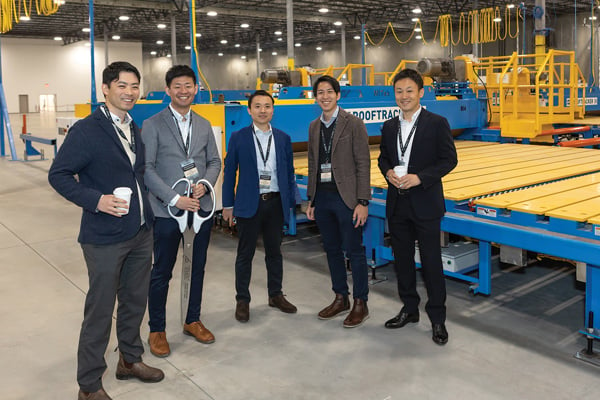
Crescent Communities’ AXIAL industrial brand completed Structural Building Solutions, a 120,000-square-foot build-to-suit development in Archdale, North Carolina, for Sumitomo Forestry Group. The facility will serve as a component manufacturing and distribution operation, producing building materials such as roof trusses, floor trusses and wall panels used in residential housing and wooden commercial and multifamily buildings. Crescent Communities
HARMON Foxbank in Moncks Corner, just outside of Charleston, South Carolina, is the latest HARMON community. “The 109 homes in this community are designed to be highly energy and water efficient so that residents have comfort and lower utility bills. In 2023, we achieved the NGBS certification on all the new HARMON homes there.”
Crescent aims to be part of the solution in resolving the housing crisis across the U.S. It formed a joint venture with Pretium in 2021, a specialized investment manager focused on real estate, and announced plans to invest in new single-family build-to-rent communities. Earlier this year, Crescent formed another strategic partnership with Heitman and a state pension fund to invest in the single-family build-to-rent platform. HARMON West Meade in Nashville will be the debut project under the new partnership, followed by three additional communities expected to break ground this year in other Sun Belt cities.
AXIAL Industrial Brand
Crescent has been active in industrial development for decades, but in 2021 it branded its industrial business line as AXIAL to further leverage brand recognition as it moved into new markets.
Crescent has completed more than $869 million in industrial projects. Its development portfolio features 63 industrial projects, with nearly 14 million square feet of completed projects and more than 3 million square feet of projects in development or operation.
One example is AXIAL Gateway 95, a rear-loaded, 505,000-square-foot building in Richmond that will be LEED certified upon completion. “We find that our end user wants that same environmental approach to industrial buildings that they have in other buildings,” Pierce said.
AXIAL Gateway 95 will feature:
- A highly reflective roof surface to reduce the heat-island effect
- All-LED lighting to reduce energy demand
- Enhanced indoor air quality to promote a healthy work environment
- Reduced outdoor water use through native and location-friendly plantings
- Responsible construction management to divert a minimum of 50% of waste from the landfill
“By constructing our AXIAL developments to be LEED certified, we project a 30% to 40% energy savings over baseline buildings in that marketplace, which is important to the tenant and to us,” Pierce said. “These buildings achieve higher rents and higher returns, so we get a double win. It is an economically more successful project, and it is more environmentally friendly.”
THE YIELD Life Science Brand
Pierce noted there are two aspects to life science: biomanufacturing and research and development. Much of the research and development is done in markets such as San Francisco, San Diego and Boston. But companies involved in biomanufacturing that want to keep operations onshore tend to target markets with a highly talented workforce and lower land costs, like the Raleigh-Durham area. The market has proximity to three tier-one research universities: Duke, North Carolina at Chapel Hill and North Carolina State.

Crescent Communities developed its first two life science projects, branded as THE YIELD, in the Raleigh-Durham, North Carolina, area in 2020. Crescent Communities
“This area has become a hotbed for life science,” said Pierce, noting that Crescent Communities developed its first two branded THE YIELD projects in the Raleigh-Durham area in 2020. “We create campuslike settings for life science and advanced manufacturing companies and primarily do biomanufacturing projects.”
A prime example is THE YIELD Holly Springs, which spans 230 acres. Crescent Communities is currently developing three distinct life science campuses located near industry giants such as Seqirus, Amgen and FUJIFILM Diosynth. The three projects will encompass 2 million square feet of biomanufacturing and lab space with over $1 billion of market value. Plans to expand THE YIELD to similar highly desirable markets are in the works.
Creating Legacies
“Receiving the Developer of the Year award is an honor for Crescent Communities and, above all, a testament to the hard work, dedication and strategic vision of our entire team,” Natwick said. “This recognition both validates our innovative and sustainable approach to development and inspires us to keep raising the bar, continually striving to create projects that not only meet the needs of today but also anticipate and address the opportunities and challenges of tomorrow. Our goal is to create legacies, ensuring the communities under our stewardship flourish for years to come, and we’re excited to continue doing so.”
Ron Derven is a contributing editor to Development magazine.
NAIOP InvolvementCrescent Communities has a history of being active within NAIOP. “NAIOP does a tremendous job promoting the commercial real estate industry,” Natwick said. “Many of our executives are involved in NAIOP at different levels. It is a wonderful forum for leaders within the industry to get together, to share best practices and to collaborate.” A number of the company’s executives participate in NAIOP at various levels, including: Leadership positions: Brendan Pierce, NAIOP Charlotte Past President; Sagar Rathie, Board of Directors and President-Elect, Programs, Committee Chair; Ben Douglas, Developing Leaders Steering Committee Member. Recognized by NAIOP: Sean McMullan, 2024-2026 NAIOP Research Foundation Visionaries Class; Sagar Rathie, 2023 National Emerging Leader Award Winner; Jack Barnett, 2023 National Developing Leaders Program. Current NAIOP members (partial list): Anthony Parker, Director of Development; Bradley Scholhamer, Development Associate; Dan Gualtieri, Director of Development; Jack Barnett, Finance Associate; Ned Austin, Vice President, Leasing; Ben Douglas, Development Manager; Bryan Blythe, Managing Director Industrial; Drew Thompson, Finance Associate; James Richardson, Development Manager; Sagar Rathie, Managing Director; Chase Kerley, Managing Director; Elizabeth McMillian, Vice President Development; Katie Maloomian, Senior Director of Development; Sean McMullan, Vice President, Capital Markets. |


